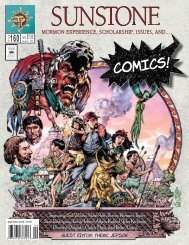is there a place for heavenly mother in mormon theology?
is there a place for heavenly mother in mormon theology?
is there a place for heavenly mother in mormon theology?
Create successful ePaper yourself
Turn your PDF publications into a flip-book with our unique Google optimized e-Paper software.
S U N S T O N E<br />
If we relegate the Heavenly Mother to the dustb<strong>in</strong> of <strong>theology</strong>, we v<strong>is</strong>it th<strong>is</strong> same<br />
treatment upon her daughters—and upon all the outcast and desp<strong>is</strong>ed.<br />
IS THERE A PLACE FOR<br />
HEAVENLY MOTHER IN<br />
MORMON THEOLOGY?<br />
AN INVESTIGATION INTO DISCOURSES OF POWER<br />
By Margaret Merrill Toscano<br />
MARGARET MERRILL TOSCANO <strong>is</strong> an ass<strong>is</strong>tant<br />
professor/lecturer of classics at the University of Utah,<br />
where she also received her Ph.D. <strong>in</strong> comparative literature.<br />
She has been on the board of the Mormon<br />
Women’s Forum s<strong>in</strong>ce its <strong>in</strong>ception <strong>in</strong> 1988.<br />
WHY ARE MOST MORMON THEOLOGIANS<br />
white males? And what does th<strong>is</strong> question have to<br />
do with the nature of Mormon <strong>theology</strong> and how<br />
it <strong>is</strong> done?<br />
Mormon <strong>theology</strong> <strong>is</strong> most often seen <strong>in</strong> either descriptive,<br />
prescriptive, or speculative terms; that <strong>is</strong>, it <strong>is</strong> either an explanation<br />
of Mormon doctr<strong>in</strong>e (descriptive), an explication of<br />
what Mormons should believe and accept as doctr<strong>in</strong>e (prescriptive),<br />
or an exploration of the implications of Mormon<br />
doctr<strong>in</strong>e and its mean<strong>in</strong>g (speculative). All three approaches<br />
can be employed by orthodox and liberal Mormons alike.<br />
Although the groups may argue about what texts, doctr<strong>in</strong>es,<br />
and approaches are most legitimate, they share two prem<strong>is</strong>es:<br />
that <strong>theology</strong> <strong>in</strong>volves a search <strong>for</strong> truth—whether it be the<br />
truth of h<strong>is</strong>torical context or ultimate div<strong>in</strong>e truth—and that<br />
truth <strong>is</strong> always knowable.<br />
While I value all three types of theologiz<strong>in</strong>g and recognize<br />
their importance <strong>in</strong> help<strong>in</strong>g us understand both h<strong>is</strong>torical and<br />
metaphysical truths, neither the approaches themselves nor<br />
the truths they seek to d<strong>is</strong>cover are value free. That <strong>is</strong>, they are<br />
conditioned by authority structures (whether ecclesiastic, academic,<br />
or cultural) that predeterm<strong>in</strong>e what gets <strong>in</strong>cluded <strong>in</strong><br />
Mormon theological d<strong>is</strong>course and who <strong>is</strong> allowed to do it.<br />
Too seldom do we consider how power structures <strong>in</strong>fluence<br />
not only what we are allowed to express but the nature of<br />
knowledge itself and how we perceive it. 1 Seldom do we ask<br />
what ideas we have failed to consider, because society’s organization<br />
creates bl<strong>in</strong>ders that block out a variety of perspectives<br />
from our view.<br />
Power structures set up frameworks <strong>for</strong> how we th<strong>in</strong>k<br />
about th<strong>in</strong>gs and whether or not we can even conceptualize,<br />
let alone promulgate, certa<strong>in</strong> possibilities. Knowledge <strong>is</strong> not<br />
separate from human relationships, and all relationships are<br />
def<strong>in</strong>ed at least <strong>in</strong> part by power. Th<strong>is</strong> means that knowledge <strong>is</strong><br />
not simply a l<strong>is</strong>t of objective propositions; it <strong>is</strong> <strong>in</strong>tertw<strong>in</strong>ed<br />
with the way people relate to each other and how they create<br />
hierarchies. Th<strong>is</strong> also means that knowledge cannot be separated<br />
from ethics; knowledge always has moral implications<br />
<strong>for</strong> how <strong>in</strong>dividuals are treated. 2 How we conceptualize the relationships<br />
among God and the members of a religious community<br />
determ<strong>in</strong>es the nature of <strong>theology</strong> and vice versa. An<br />
example may help clarify my po<strong>in</strong>t.<br />
In a recent Ensign article, President H<strong>in</strong>ckley outl<strong>in</strong>es the<br />
four theological foundations of Mormon<strong>is</strong>m—the “Four<br />
Cornerstones of Faith.” The first <strong>is</strong> the “testimony of Jesus<br />
Chr<strong>is</strong>t as the Son of God”; the second <strong>is</strong> the “First V<strong>is</strong>ion of the<br />
Prophet Joseph Smith”; the “third cornerstone <strong>is</strong> the Book of<br />
Mormon”; and the fourth <strong>is</strong> “the restoration to earth of priesthood<br />
power and authority.” 3 While these four propositions<br />
may appear fairly neutral, they all have implications <strong>for</strong> how<br />
women are positioned <strong>in</strong> the Church organization s<strong>in</strong>ce all<br />
four cornerstones center on male figures (who are represented<br />
as white). Th<strong>is</strong> non-neutrality becomes more obvious when we<br />
look at the four pictures the Ensign uses to illustrate each of the<br />
pr<strong>in</strong>ciples. The first and largest <strong>is</strong> a lov<strong>in</strong>g picture of Chr<strong>is</strong>t<br />
hold<strong>in</strong>g a staff (The Lord Is My Shepherd by Simon Dewey); the<br />
second shows a young Joseph Smith on h<strong>is</strong> knees be<strong>for</strong>e God<br />
(Joseph Smith’s First V<strong>is</strong>ion by Greg Olsen); the third portrays<br />
the prophet Mormon writ<strong>in</strong>g (Mormon Abridg<strong>in</strong>g the Plates by<br />
Tom Lovell); and the fourth depicts John the Bapt<strong>is</strong>t bestow<strong>in</strong>g<br />
PAGE 14 JULY 2004
















